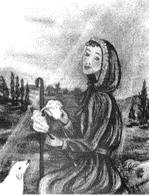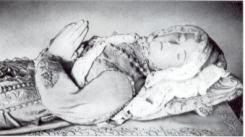Today, June 15, we celebrate the feast day of Saint Germaine Cousin (1579-1601), virgin of the Church, a long-suffering young woman who despite her trials lived a life of simple love and adoration of the Lord. Through her witness, the grace and peace of Christ shone into the lives of those she encountered, deepening faith, affecting conversion, and working miracles. Saint Germaine Cousin is the patron saint of victims of child abuse, a problem that continues to impact millions of children world-wide each year, and an estimated 800,000 children in the United States. UNICEF estimates that nearly 20% of girls and 10% of boys will be victims of physical or sexual abuse prior to the age of 18. From this startling statistics, it is clear that our world needs the intercession of Saint Germaine now, more than ever!
Germaine was born to a poor farming family in Pibrac, France, just north of Toulouse. She was born quite ill, and suffered numerous birth defects including a paralyzed and deformed right hand. Her mother, who passed away while Germaine was an infant, was a pious and loving woman who efficiently ran the household, caring for Germaine and nurturing her through frailty and sickness. Upon her death, Germaine’s father was left unable to care for himself and quickly re-married a mean-spirited and cruel woman named Hortense. Germaine’s new stepmother quickly turned on her, subjecting her to emotional and physical cruelties and insults. Her father, afraid to lose his new wife, pretended not to notice, focusing his attention on the new children that he and Hortense produced.
Germaine, just a girl, was left to fend for herself. Given virtually no food—even as a toddler—she learned at an early age to crawl to the dog’s dish, eating discarded scraps left for the shepherding canines. While caring for the farm’s chickens, Hortense set the infant Germaine down on a recessed grate, forgot about her, and left her in the cold barn for three days before finding her. She further scalded the young girl’s legs with hot water, beat her, and fed her scraps—all for imagined misdeeds.
Germaine, who Hortense quite vocally considered ugly, grew frailer and sicker from her mistreatment, coming down with a form of Tuberculosis which causes bleeding sores and lesions and swelling of the neck. Repulsed by her step-daughter’s appearance, and afraid that she would spread her disease to the other children, Hortense forced sickly Germaine to sleep in the barn. There, she received comfort and warmth from the sheep of the family’s flock, burrowing beneath their wooly coats during the frigid winters.
Sadly, having learned by watching Hortense, Germaine’s step-siblings were no more kind to her than her stepmother. The spent their days in leisure, tormenting Germaine, while she performed household chores. When she was provided with food, her step-siblings made sure that they had mixed inedible ash into it. On the rare occasions she was given clean clothing, they quickly covered it with pitch from the trees, making it sticky and unwearable.
Starving, maligned, sick, and ill-treated, Germaine never once cried out in hatred. Rather, she turned to the Lord. Uneducated, when she was nine years old she was put in charge of the family’s flock of sheep, with whom she spent her days in the fields. With only sheep for company, Germaine prayed the few prayers she had memorized in Catechism, as well as a homemade Holy Rosary, made from knotted string, which she carried in her pocket. Her favorite prayer was simple and obedient: "Dear God, please don't let me be too hungry or too thirsty. Help me to please my mother. And help me to please you." From her simple request, repeated daily, grew an inspiring faith, profound holiness, and a deep trust of God.
Saint Germaine was especially devoted to Our Blessed Mother. Not only did she make and pray the Rosary, she gathered children of the village to teach them the catechism, demonstrating with her Rosary, and instilling in them the love of Jesus and Mary. Her devotion to the Angelus is said to have been so great that she would fall on her knees at the sound of the bells, even if she were crossing a stream.
Saint Germaine left her flock each day, in the care of the Lord and her guardian angel, setting down her staff and crook, and walking into the nearby town to attend daily Mass. She never worried about her sheep, confident that the Lord would watch over them. And despite the constant threat of thieves and wolves, no harm every came to her flock. Miraculously, on a day when it had rained torrentially, local villagers witnessed the swollen river that Germaine was forced to cross on the way to Mass part, allowing her to walk on dry land to the church.
Despite having so little, Germaine readily shared all she had in love and charity. The few scraps she was provided for food each day more often than not were given to those less fortunate than her. Her clothing, thin and unsuitable for the cold winters, could be found on the shoulders of those she encountered, she, herself, preferring to go cold than watch another suffer. She engaged in many self-imposed austerities, in reparation for the sins of the world. Her life of charity, self-denial, penance, and piety became well known to the townspeople, who began to look upon her with respect and awe.
When word of her holiness reached her stepmother, Hortense was predictably angry. Hoping to catch her step-daughter giving away the family’s food after discovering that she had let a beggar sleep in the barn, Hortense confronted Germaine. Livid, she knocked the wrapped bundle that Germaine was carrying from her arms, expecting to see the family’s bread being given away to the hungry. Instead, despite it being in the midst of winter, when Germaine opened her apron, out fell bright beautiful flowers should not have been in bloom until springtime. Germaine handed her stepmother a flower saying, "Please accept this flower, Mother. God sends it to you in sign of his forgiveness." In her heart, Germaine had forgiven her stepmother—the woman who had tormented her for years—as well.
As the days went on, Hortense began to change, softening at first, later inviting Germaine back into the house to sleep. Germaine, now used to the straw of the barn, and not wishing to become too comfortable when so many were suffering, refused. It was there, laying in the barn with her sheep, with her Rosary entwined in her fingers, she died peacefully at age 22, her long, difficult life finally taking its toll on her frail body. That same morning, a group of traveling priests and religious hurried into the village, saying: "Last night I saw a virgin going up to Heaven. She was wearing a brilliant crown and was accompanied by a crowd of angels that were brighter than the stars." The faithful townspeople knew at once that it was Germaine, the holy shepherdess.
Saint Germaine’s body was buried in the church at Pibrac, her simple life, faith, and holiness momentarily forgotten about by the world, except by the local devout who recounted stories of her piety and the miracles they had witnesses. Forty years after her burial, the body was exhumed and found to be incorrupt, exuding the sweet smell of sanctity, smiling a gentle smile. Two hundred years following that, during the French Revolution, heretics opened her lead casket and desecrated her body, again finding it incorrupt. Following the war, her undamaged body (save where some lime had been thrown on her garments) was re-interred. The Lord had preserved His beautiful creature, and immediately numerous miracles were attributed at her tomb and through her intercession. As of today, over 400 miraculous cures, multiplications of food, and other miracles have been recorded. Annually, thousands of faithful continue to visit the church at Pibrac on pilgrimage, to pray before her relics.
Saint Germaine’s life reminds us that we all are burdened in some way by shortcomings—whether it be loneliness, dissatisfaction with our appearance, illness, infirmity, poverty, hardship… the list is endless. Saint Germaine suffered all of these trials, and did so joyfully, looking to the Lord for guidance and safety, thanking Our Blessed Mother for the many graces she had received. We pray today for the simple faith and obedience of Saint Germaine—that we, too, may turn to the Lord in our times of deep distress and hurt, and simply pray that despite our weaknesses, we please Him.
O Saint Germaine, look down from Heaven and intercede for the many abused children in our world. Help them to sanctify these sufferings. Strengthen children who suffer the effects of living in broken families. Protect those children who have been abandoned by their parents and live in the streets. Beg God's mercy on the parents who abuse their children. Intercede for handicapped children and their parents.
Saint Germaine, you who suffered neglect and abuse so patiently, pray for us. Amen.
Why pray the Rosary every day for a year?
Each time the Blessed Virgin has appeared-- whether it be to Saint Bernadette Soubirous at Lourdes; to Lucia, Jacinta, and Francisco at Fatima; or to Mariette Beco at Banneux-- she has asserted the importance, saving grace, and power of praying the Holy Rosary on a daily basis. Based upon her words, the Rosary is penance and conversion for sinners, a pathway to peace, an end to war, and a powerful act of faith in Jesus Christ. Pope Paul VI presented the Rosary as a powerful means to reach Christ "not merely with Mary but indeed, insofar as this is possible to us, in the same way as Mary, who is certainly the one who thought about Him more than anyone else has ever done."
To show us how this is done, perhaps no one has been more eloquent than the great Cardinal Newman, who wrote: "The great power of the Rosary consists in the fact that it translates the Creed into Prayer. Of course, the Creed is already in a certain sense a prayer and a great act of homage towards God, but the Rosary brings us to meditate again on the great truth of His life and death, and brings this truth close to our hearts. Even Christians, although they know God, usually fear rather than love Him. The strength of the Rosary lies in the particular manner in which it considers these mysteries, since all our thinking about Christ is intertwined with the thought of His Mother, in the relations between Mother and Son; the Holy Family is presented to us, the home in which God lived His infinite love."
As Mary said at Fatima, "Jesus wants to use you to make Me known and loved. He wishes to establish the devotion to My Immaculate Heart throughout the world. I promise salvation to whoever embraces it; these souls will be dear to God, like flowers put by Me to adorn his throne."

Subscribe to:
Post Comments (Atom)



















0 comments:
Post a Comment
Thanks for leaving a comment. If you wish to submit a prayer request, however, please do so above, using the "Contact" tab.